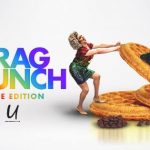Ruralists
As I trek through an overgrown field of tall grass and wildflowers in Zanesville Ohio, I can see the Columbia Portland Cement factory huddled in the distance. It’s a massive abandoned compound surrounded by wilderness; nestled inside are six 80-foot-tall silos, an office building, machine shops, and a powerhouse—all overgrown with moss and corroded with rust.
Behind me is Mandi Caskey, aka Miss Birdy, who is carrying a bag of spray paint, brushes, trail mix, bananas, and a gallon of water. In front of me is Jacob Tanner, his massive black pack stuffed with art supplies, buckets of paint and gallons of water lazily hanging off the sides as he grunts forward. I faithfully follow through the brush, toting a milk carton filled with a rainbow variety of different colored spray paints. I realize that we’re essentially hiking into their studio.
Caskey and Tanner are both professional muralists who come here frequently to paint. As we step inside the main structure, dozens of their detailed murals ornament the decomposed walls—from exquisitely decorated sunflowers to colorfully shaded birds to frighteningly wicked clown faces with sharp teeth and red eyes. For them, this building does not represent vandalism. It’s a place where they create art without distraction or limitation. While the pair do plenty of commissioned work, this is where both artists get to do what they want.
“And if we are the only ones here to see it, then it is our moment—our time,” Caskey says. “Until we found out about these places, we weren’t even sure that we could paint this big. To be here is to explore the thought and execute.”
Back in Columbus, Caskey is currently working on a 5-by-28 mural for the Rhodes State Office, one that features the state symbols interacting with each other in the natural habitat. They are both working on the design background of the main music stage for the Independents’ Day Festival and have both participated in Urban Sprawl and Chalk the Block. As a result, I feel a bizarre sensation of duality seeing their work displayed in the middle of nowhere, Ohio—sharing wall space with crudely spray-painted phalluses and swastikas.
“They,” Caskey says in reference to the creators of those images, “are there to vandalize. We are here to beautify.”
It’s hard to argue against that sentiment. Spaces that have spent decades as reminders of a grander industrial era—once filled with bustling factory workers and buzzing machinery—are now being given new energy. Call it an artistic resurrection—or, as Tanner puts it, “contemporary muralism.”
“It’s an international movement that spawned from the golden age of hip-hop culture in New York during the ’80s and ’90s,” he said. “This was when subway graffiti was in its grimiest and most beautiful state. It’s important to know your roots. The spray-can opened up a lot of opportunity for growth for painting and murals in general.”
“With a paintbrush you have to take a lot of time, but with a spray-can you can cover an entire wall in under an hour,” added Caskey.
A few days prior, I met Tanner and Caskey in a small, abandoned steel factory on the south side of Columbus. Caskey, garbed in a flowered black sundress and combat boots, was recreating a black and white photo of her grandmother drinking a glass of water. She told me that her grandmother had a lot of influence on her life as an artist. Now, she is immortalized on a decomposed factory wall.
Tanner, awkwardly nestled inside a large silo, was painting a drooping sunflower. A beam of light glimmered though the top of silo and onto his flower; a deliberate touch that made his mural seem to come to life. After watching them paint for a while, they invited me to go to Zanesville—to a place they said kicks way more ass.
So now we are here, and they are both hard at work. I take out my guitar and sing a song that bounces delicately off the tall ceiling, echoing throughout the spacious chamber. Tanner is creating a red submarine in a large, black sea filled with spiked landmines; two bald sailors are huddled in, looking worried. The mural is cartoony, whimsical, and nostalgic; as though it was from a crazy dream I had when I was 10.
“When I was a kid I had an uncontrollable imagination,” said Tanner. “I daydreamed a lot about escapism, which got me into loads of trouble.” The submarine symbolizes the adventure and escape that he sought after as a kid. “I hold my ability to imagine very dearly to my heart, so the submarine is a reminder to hold onto the spirit I had as a child. That spirit often dies in people.”
“I hold my ability to imagine very dearly to my heart, so the submarine is a reminder to hold onto the spirit I had as a child. That spirit often dies in people.”
Caskey was outside in the factory’s courtyard painting a cracked egg on a deserted wall. The egg, of course, conformed to the niche of her namesake, Miss Birdy.
“I was attacked by birds several times growing up, so I had a horrible phobia,” she said. “When I started creating murals, the idea of a 9-foot rooster or bird made me uncomfortable. So I wanted to create it.”
For Caskey, facing her fears was a big part of her transformation into adulthood, and she wanted her birds to be representative of that. “The bird series may not continue, but that underlining theme will.”
I walk outside to watch Caskey work; the August sun has her back beating a vibrant pink. She is feverishly splashing black paint over the yellow and orange egg yolk, which is lazily spilling out of the bottom of her egg. “It’s not right. I don’t like it,” she says, breathless. Though she considers her egg a failure, her time here is not wasted. What makes this experience important is practicing, getting better, and living in the moment; after all, sometimes you need to crack a few eggs to make a proper omelet.
As we leave, the sun begins to set in the distance. Tired, covered in cobwebs and dust, we gather our supplies and make our way back to the car. I learned today that sometimes art is found in the least expected places, like a detailed painting in a forsaken factory. Sometimes, you just have to stop what you’re doing and search for beauty in grime.
For more, follow Caskey (@miss.birdy) and Tanner (@the.trumpeteer) on Instagram.
BROUGHT TO YOU BY






